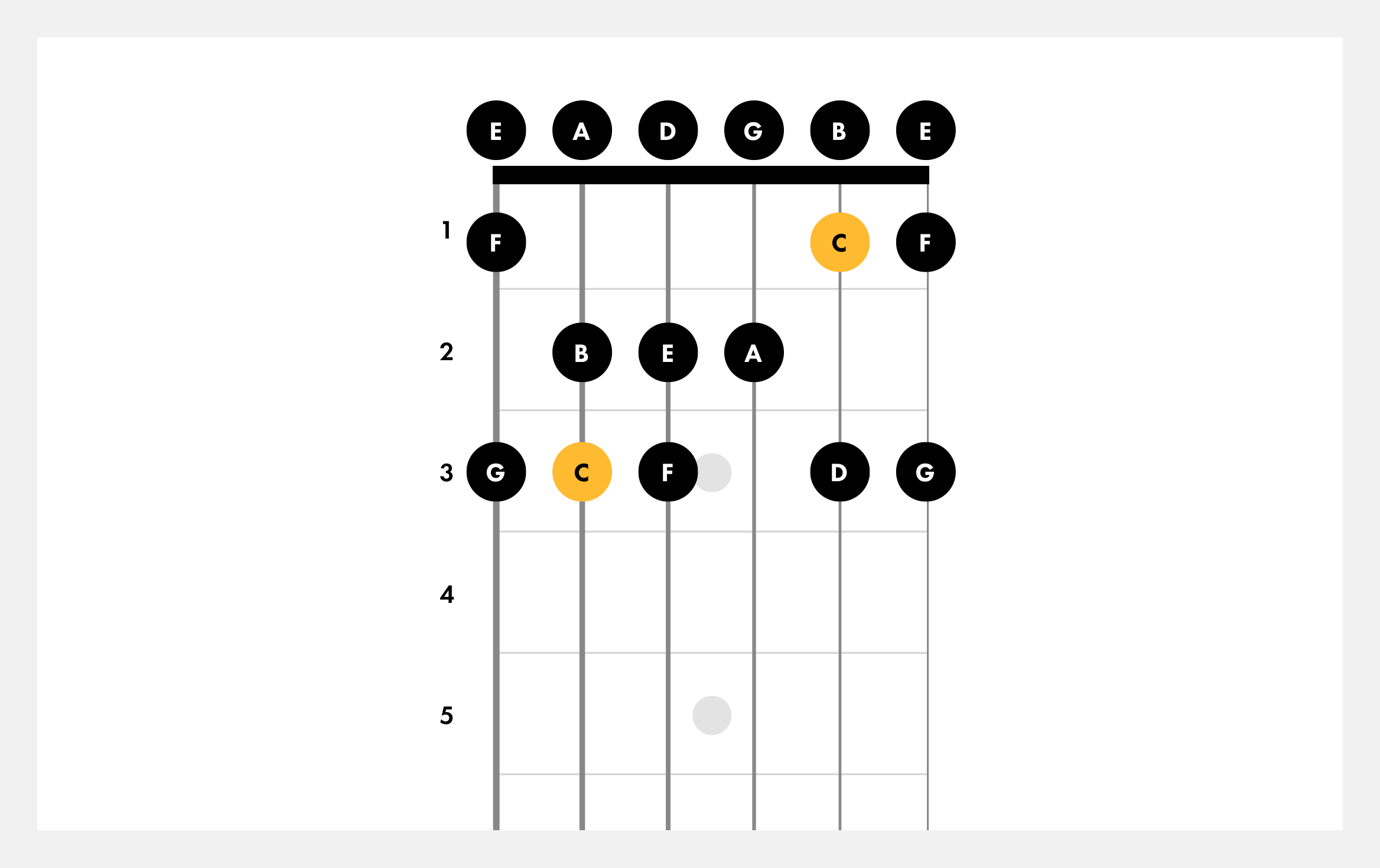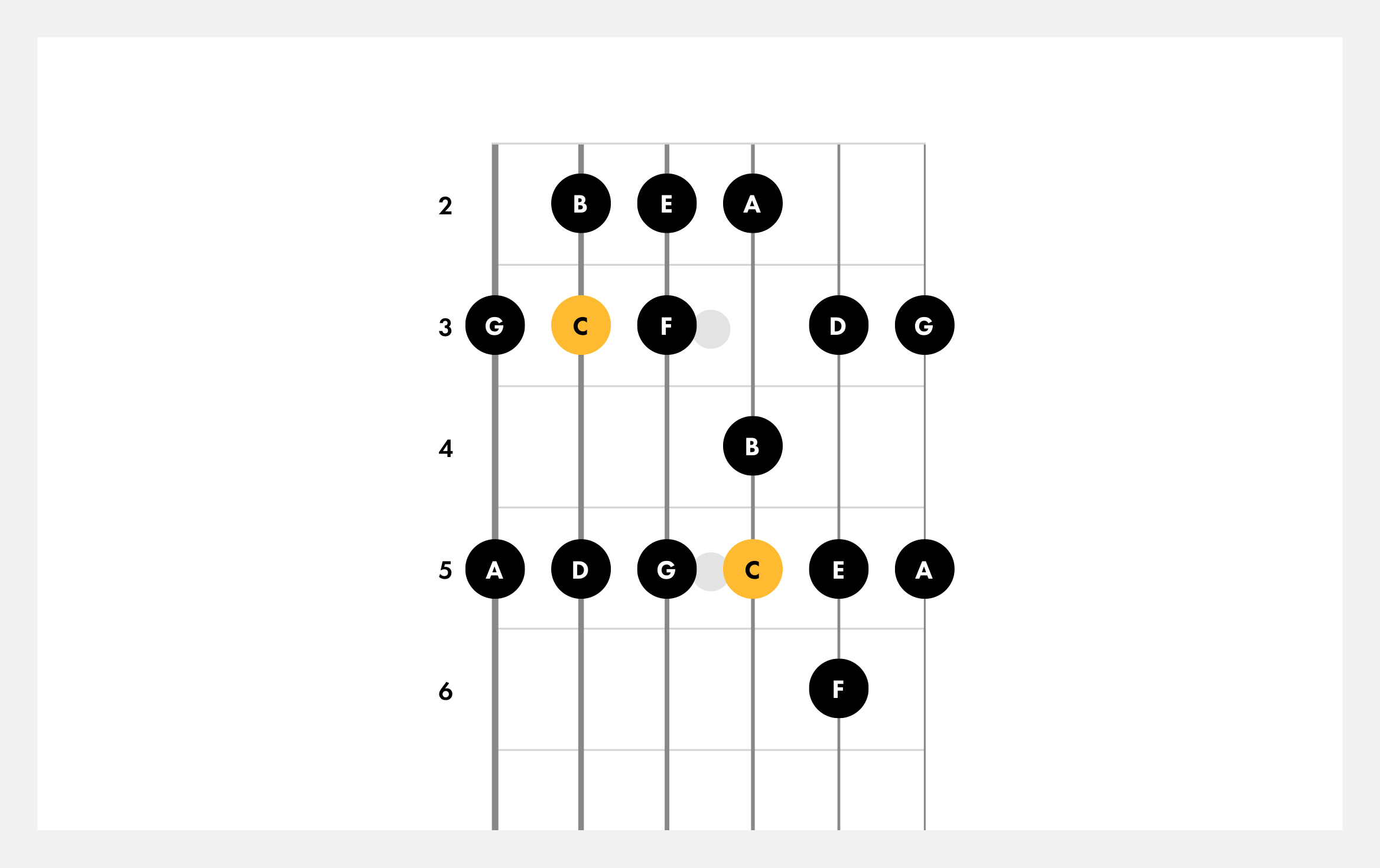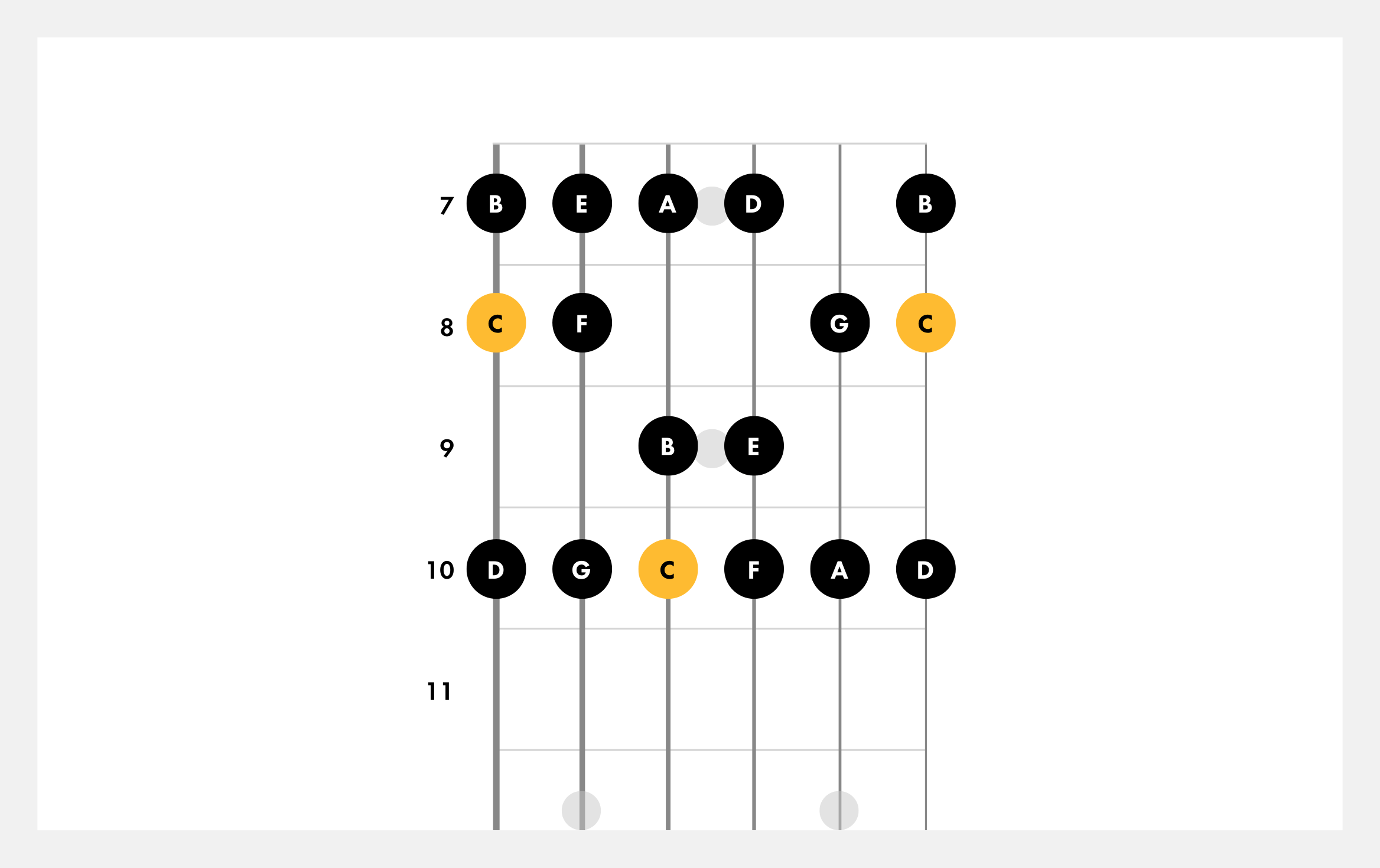
Sections
Lesson: Playing the C Major Scale on Guitar
The C major scale is a great guitar scale for beginners to start with because many other instruments, like the piano, are played in the key of C. This will help you learn to play along with other instruments as you advance in your guitar-playing journey.
Part of what makes the C major scale great scale for beginners is that it does not contain any sharps or flats (think of playing only the white keys on a piano). This allows you to hear each note in its purest state
In this lesson, we’ll go over the notes in the C major scale and hand and finger positions. Once you’ve mastered the basics, you’ll be able to add chords using the same notes to create a harmonized C major scale. You can harmonize the C major scale (and any other scale for that matter) by adding chords that contain the notes from the scale. (We’ll get into that more below!) The first step to learning a scale is to understand which notes you will play.
C Major Scale Notes
C
D
E
F
G
A
B
Next, we’ll go over the C major scale positions so you’ll know which hand shapes and fingers to use to play each note on each string.
Don’t miss out!
Be the first to know about new products, featured content, exclusive offers and giveaways.
C Major Scale Positions
In order to play the C major scale, you’ll need a basic understanding of how to read guitar neck scale diagrams. In the example below, the numbered dots represent how the scale pattern appears on your guitar’s fretboard. The individual numbers correspond to each finger to show you which one to use for each note. Use this key to determine proper finger placement:
Index finger
Middle finger
Ring ringer
Pinkie
Thumb
The white dots in the diagram represent the open strings.
Like all scales on the guitar, the C major scale consists of different finger positions. In order to play the scale, you’ll build up finger dexterity to breeze through touching your fingers to the right frets in order to play a C major scale.
There is a different scale position for each of the notes in the C major scale (C, D, E, F, G, A, and B). Each note of the scale has its own position.
In this lesson, we’ll cover six C major scale positions.
Open Position
When playing C major in the open position, you’ll keep your fingers confined to the first three frets. Use your index finger to play the notes on the first fret, your middle finger for notes on the second fret, and your ring finger for notes on the third fret.

1st Position
C major in 1st position adds in the fourth fret. You can see the notes you’ll play in this position in the diagram below.

4th Position
Playing C major in the 4th position will require more finger movement, but learning this position will allow you to improvise and play notes up and down the guitar neck! In 4th position, you’ll use your index finger to play notes incorporating the fifth fret, You’ll use your middle finger to play the notes on the sixth fret, your ring finger to play the notes on the seventh fret, and lastly, your pinkie to play the notes on the eighth fret.
To play the notes on the third string, you’ll need to shift your fingers. Move your index finger to the fourth fret to play the B note and use your middle finger to play the C note on the fifth fret. You’ll play the D note on the seventh fret with your pinky. Then, shift your index finger back to the fifth fret on the first and second strings.

7th Position
Playing C major in 7th position uses the seventh, eighth, ninth, and 10th fret. While this sounds like you’ll incorporate a lot of new frets, this position actually requires less shifting around compared to 4th position.

8th Position
When playing the C scale in the 8th position you’ll use the 8th, 9th, 10th, 12th, and 13th frets.
12th Position
In 12th position, you’ll use the first four fingers to play the notes on the 12th, 13th, 14th, and 15th frets as shown below.
C Major Scale Guitar Tabs
The C Major scale isn’t just played on one string, you can play several combinations using different strings as you work down the neck of your guitar. Here, we’ll go over how to play the C Major scale using different guitar tabs.
C Major Scale Starting on the low E or 6th string
Beginning on the high “E” string, you would play the C Major scale like this. (Then you’d play it in descending order to hear it in reverse.)
C Major Scale Starting on the lo A or 5th string
To hear the C Major scale on a lower register, you can begin playing it on the A string like this:
C Major Scale Starting on the low D or 4th string
Starting on the D (4th string), you can play the C major scale like this. The bulk of your fingerwork will be concentrated on shifting your positions across the B string -- spanning between the 10th and 13th frets.
C Major Scale Starting on the low G or 3rd string
Another way to play the C Major scale is to start on the G (or 3rd string), beginning on the 5th fret and concentrating your fingerwork on the high “E” string, spanning the 5th and 8th frets, descending back to the G string.
C Major Scale Chords
The C Major Scale has a number of chords that are associated with this particular scale. Just as the C major scale has 7 notes, there are 7 guitar chords or triads in the C major scale. Here, we’ll get into some basic music theory to introduce you to the C major scale guitar chords. As we introduce each chord, use the diagrams to see which strings to play with which fingers.
C Major
A major chord has three parts: the root note, the major 3rd, and the perfect 5th. For the C major chord, the root note is C, the major 3rd is E, and the perfect 5th is G. Learn how to play the C major chord here.
D Minor
For D minor, the root note is D, the minor 3rd is F, and the perfect 5th is A. Check out how to play the D minor (or Dm) chord here.
E Minor
Another minor chord that corresponds with the C major scale is the E minor (or Em) chord. In E Minor, the root note is the E, the minor 3rd is the G, and the Perfect 5th is the B. Learn how to play it.
F Major
Switching from minor chords that work within the C major scale, we shift gears back to major chords. Following our formula for F major, the root note is F, the minor 3rd is A, and the perfect 5th is C. Discover how to play the F major chord here.
G Major
For G major, the root note is G, the major 3rd is B, and the perfect 5th is D. Here’s how to play the G major chord.
A Minor
For the A minor chord, the root note is A, the minor 3rd is C, and the perfect 5th is E. Learn how to play the A minor (Am) chord.
B Diminished
This chord consists of the root note of B, the minor 3rd D, and the perfect 5th F. This diagram shows you how to properly position your fingers to play the B dim chord.
C Major Scale Exercises on Guitar
To tie everything together and help you learn the C major scale, let’s try some C major guitar exercises. Make sure you’ve practiced the C major chords and the guitar positions above before tackling these exercises. Once you have memorized those chord forms, these exercises will help you to keep your fingers nimble and more easily find their way along the fretboard.
The best way to learn the C major scale is to literally practice from the lowest root note to the highest root note forward, playing the notes in both ascending and descending order. That’s exactly what we’ll do in these exercises!
C Major Scale Ascending and Descending
To play the C major scale ascending, start with the root note C and play the notes in order: C - D - E - F - G - A - B - C. Then, go right back down the scale: B - A - G- F- E - D, until you’ve made your way back to the lower C.
Referencing the scale tablature above, you can practice these drills and exercises in the open, first, fourth, or other positions. Try playing each one -- forward and backward -- to see how different each one sounds in terms of tone and octave. Regardless of what position you play the C major scale, it will still include the same notes, but some may be at a higher or lower pitch than others.
Playing these scales at different positions will help you train your ear to hear the same note at different pitches.Diminished
If you'd like to learn how to play even more chords, browse Fender Play's chord library, learn about chord types, and find tips on how to master them.
If you're not a member yet, sign up for a free Fender Play trial!


